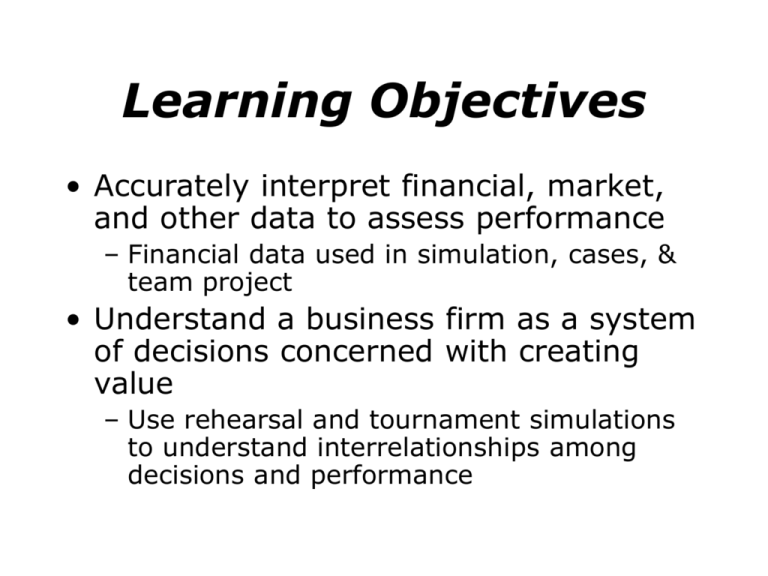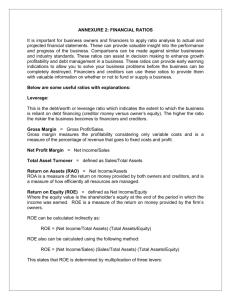notes on financial reporting and ratios
advertisement

Learning Objectives • Accurately interpret financial, market, and other data to assess performance – Financial data used in simulation, cases, & team project • Understand a business firm as a system of decisions concerned with creating value – Use rehearsal and tournament simulations to understand interrelationships among decisions and performance Review - some key financial measures Balance Sheet Assets Liabilities Equity Liabilities and equity = sources of funds. Assets = uses of funds (good & bad). Liabilities = debt claim. Equity = ownership claim. Financial Measures ST Assets ST Liabilities LT Assets LT Liabilities Equity Capital Budgeting Deals with the firm’s investment in long-term assets e.g., in what capabilities/capacities should you invest? Financial Measures ST Assets ST Liabilities LT Assets LT Liabilities Equity Capital Structure Deals with long-term financing of the firm’s activities e.g., what mix of long term debt and equity will you use? Financial Measures ST Assets ST Liabilities LT Assets LT Liabilities Equity Working Capital Management Deals with management of short-term (current) assets. e.g., will you delay payables, speed up collections, manage inventory to expected, best, or worst case sales, etc. Financial Measures Liquidity Ratios Current Ratio: Current Assets / Current Liabilities Quick Ratio: (Current Assets - Inventories) / Current Liabilities High values - company will not default on short-term obligations (if too high, profitable opportunities may be lost). Financial Measures Leverage Ratios Debt to Equity Ratio = Tot Debt / Tot Equity (degree of reliance on debt for financing). Low ratios suggest more conservative (safe from bankruptcy) company But - if not using debt, you are foregoing investment and growth opportunities. Financial Measures Some common profit ratios Return on Sales ROS = Profit after taxes/Sales Return on Assets ROA = Profit after taxes/Total Assets Return on Equity ROE = Profit after taxes / Shareholders’ Equity (book value) Earnings per Common share (EPS) = (Profits after taxes - Preferred Dividend) / (# of common shares outstanding) Payout Ratio = Cash Dividends / Net Income But these ignore the cost of capital (interest, dividends) Financial Measures DuPont formula points to interrelatedness of performance measures Profit margin X asset turnover X equity multiplier = ROE Net income/sales X sales/assets X assets/equity = ROE Net income/sales X sales/assets X assets/equity = ROE Net income/sales X sales/assets = ROA Net income/sales X sales/assets = ROA ROE is positively related to the efficiency of the firm in managing its shareholders’ equity (generally). A firm can increase ROE by any of the ratios in the DuPont formula. Increases in net profit margin will improve ROE. If a firm can get more sales out of its existing assets, ROE will improve. If a firm increases leverage or debt load, ROE increases (all other things equal). Caution - if a firm’s ROE increases or is trending up, it may be that a firm is increasing leverage without strategic use of assets. Improvement in ROE may artificial, possibly fatal in the long-term. If a company is consistently increasing profit margin, find out why - if margins are achieved through cost cutting, an uptrend in ROE may not continue. Market to Book Ratio M/B M - investors’ assessment of the present value of the expected cash flows from assets in place, and cash flows from investments the firm would have an opportunity to make some time in the future. B - accountant’s perspective - historical measure of equity resources contributed by shareholders. The value of a firm is determined by what people are willing to pay for it. Value depends on future expectations of earnings & growth. Financial Measures Source: A. Hax, MIT OCR






